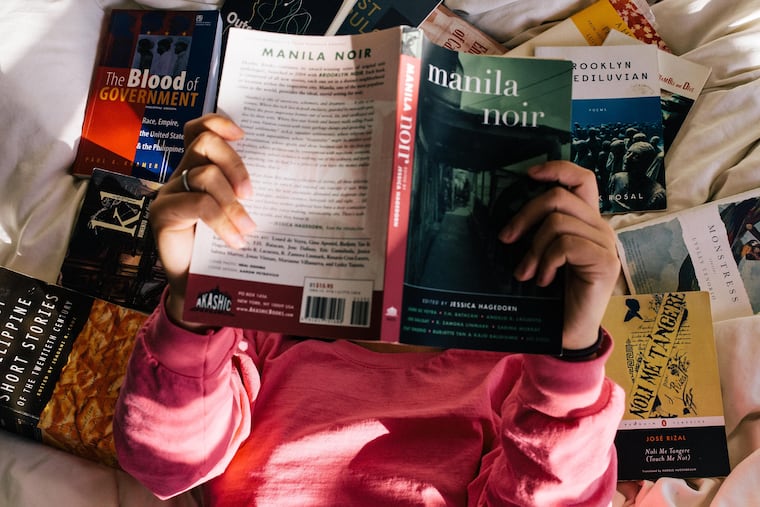10 Filipino American books that made me feel more Filipino
For years I’ve tried to forge a connection with the place where my parents grew up. Books have been one of the best ways I've found to do that.

We were barreling across the waters of Palawan when I saw it — Culion, a Philippine island that was once a leper colony. A flicker of recognition, and the pleasure that comes with it, washed over me.
I had read about this island before, had this feeling before: First, in a short story by Lysley Tenorio, “A View From Culion,” and then in a poem by Patrick Rosal, “Instance of an Island,” where he writes of a pair of “incurables,” Josefa and Filomena, who, despite having only 10 fingers between them, find solace jamming on the hospital’s sole guitar.
And now I was seeing the island itself, even if only from a distance, like a piece of a puzzle falling into place.
For years I’ve tried to forge a connection with the place where my parents grew up, tried to make sense of what it meant to be Filipino if I couldn’t speak the language, if I didn’t live there, if I kept getting food poisoning every time I visited. It’s a common experience for those of us who’ve spent their lives far from our parents’ old homes.
But, books. Books, I’ve found, are among the most powerful ways to develop this lineage of mine, one that felt tenuous at first but has grown stronger with each story, with each reference I catch.
Here’s a list of my favorite Filipino American books, which is by no means conclusive. There are still so many more on my list to read, including Jon Pineda’s Let’s No One Get Hurt and Anthony Christian Ocampo’s The Latinos of Asia.
‘America Is Not the Heart’ by Elaine Castillo
Castillo’s debut novel — which takes us from a rebel army’s hideaway in the mountains in the Philippines to a Filipino community in the Bay Area and covers topics like class, queer love, and chosen families — had me choked up by the time I finished the prologue.
'Dream Jungle’ by Jessica Hagedorn
Start looking into Filipino fiction and you’ll find that Hagedorn is the queen, with her trademark spiky hair and penchant for bringing to life a frenzied array of characters: lowlifes, scammers, desperate lovers. In Dream Jungle, she imagines what it was like on the set of Apocalypse Now, which was filmed in the Philippines, and what was going on in the head of a man who said he had discovered a “lost” Filipino tribe.
'Uprock Headspin Scramble and Dive’ by Patrick Rosal
Read Patrick Rosal — whom Philly can claim as one of its own — for his poems about getting into barfights with light-skinned Filipinos. Read Rosal for his meditation on Los Angeles as a kind of afterlife for his mother. Read Rosal because who else can write as beautifully about fantasizing about Tyra Banks? Just read him, always read him.
'Monstress’ by Lysley Tenorio
My main memory of reading Lysley Tenorio’s short-story collection is lying on my Ninang’s couch and sobbing. That, and sharing it with my long-distance Filipina book club, who were similarly shook. His story, “Felix Starro,” was turned into a musical this year in a Filipino power collab with Queen Hagedorn.
‘In the Country’ by Mia Alvar
Another stirring short-story collection, whose title story explores a labor struggle at Manila’s City Hospital in the ’70s about a pay disparity between Filipino and American nurses and the lasting consequences for the nurse who led the strike.
‘Kuwento: Lost Things (An Anthology of New Philippine Myths)’ edited by Rachelle Cruz and Melissa Sipin
On the witches, ogres, and beasts that haunt Filipino children at night: aswangs, kapres, and the great bu’aia.
‘The First Impulse’ by Laurel Fantauzzo
I was gripped by this creative nonfiction work — a murder mystery, a love story, a tribute to the indie film scene in Manila — and even ordered a second copy so I could lend it out to more friends. Fantauzzo’s next is due in 2021.
The Philippines was an American colony for almost 50 years — something I never learned in school. This book, which traces that overlooked history, is, at times, painful to read.
'Outsourceable Selves: An Ethnography of Call Center Work in a Global Economy of Signs and Selves’ by Alinaya Fabros
I’m a labor reporter! So of course I devoured this book about the Filipinos that do the hard, invisible work of customer service for corporations.
‘Empire of Care: Nursing and Migration in Filipino American History’ by Catherine Ceniza Choy
Another Filipino labor reporter treasure, this one answering the question of why there are so many nurses from the Philippines in the States.